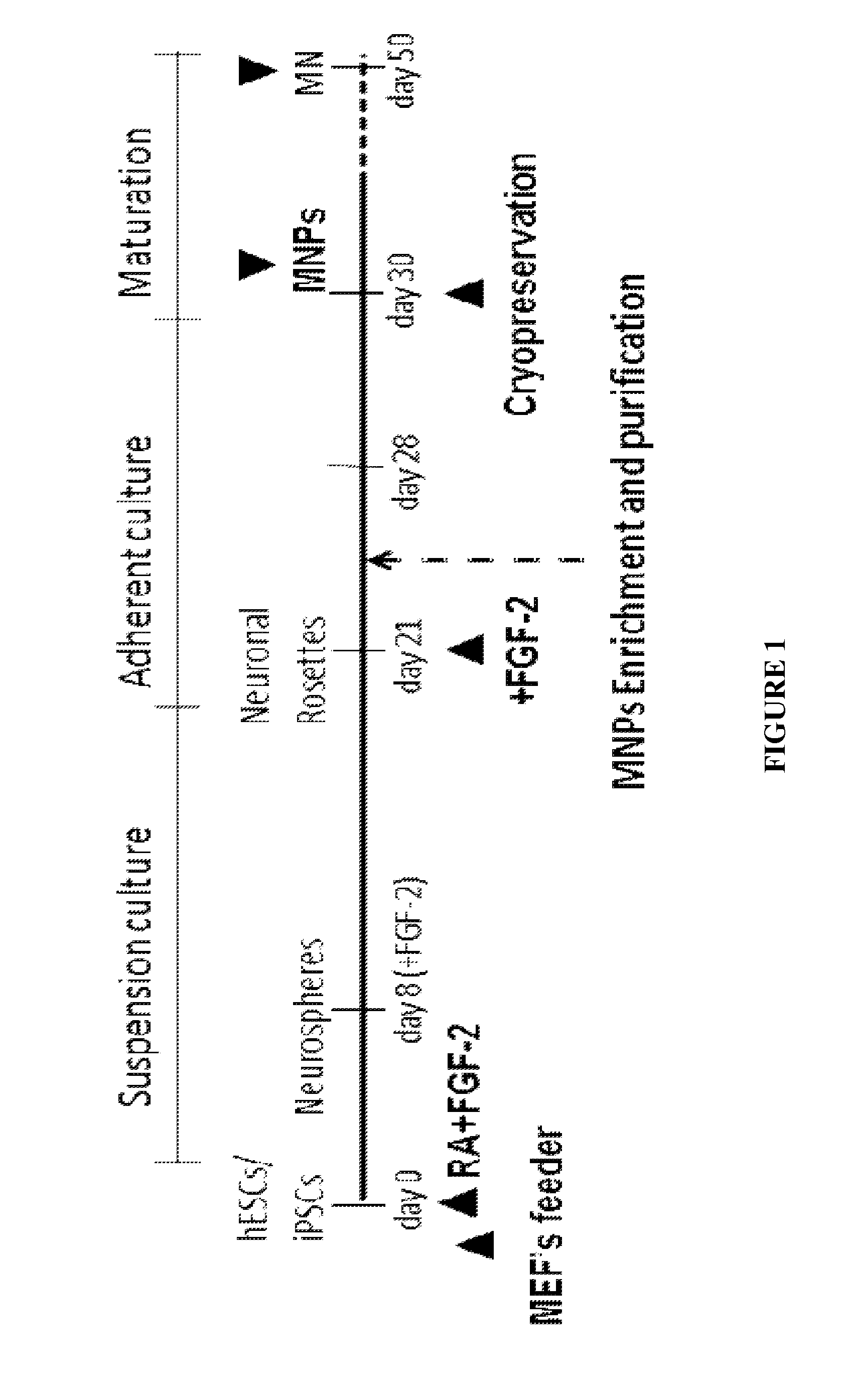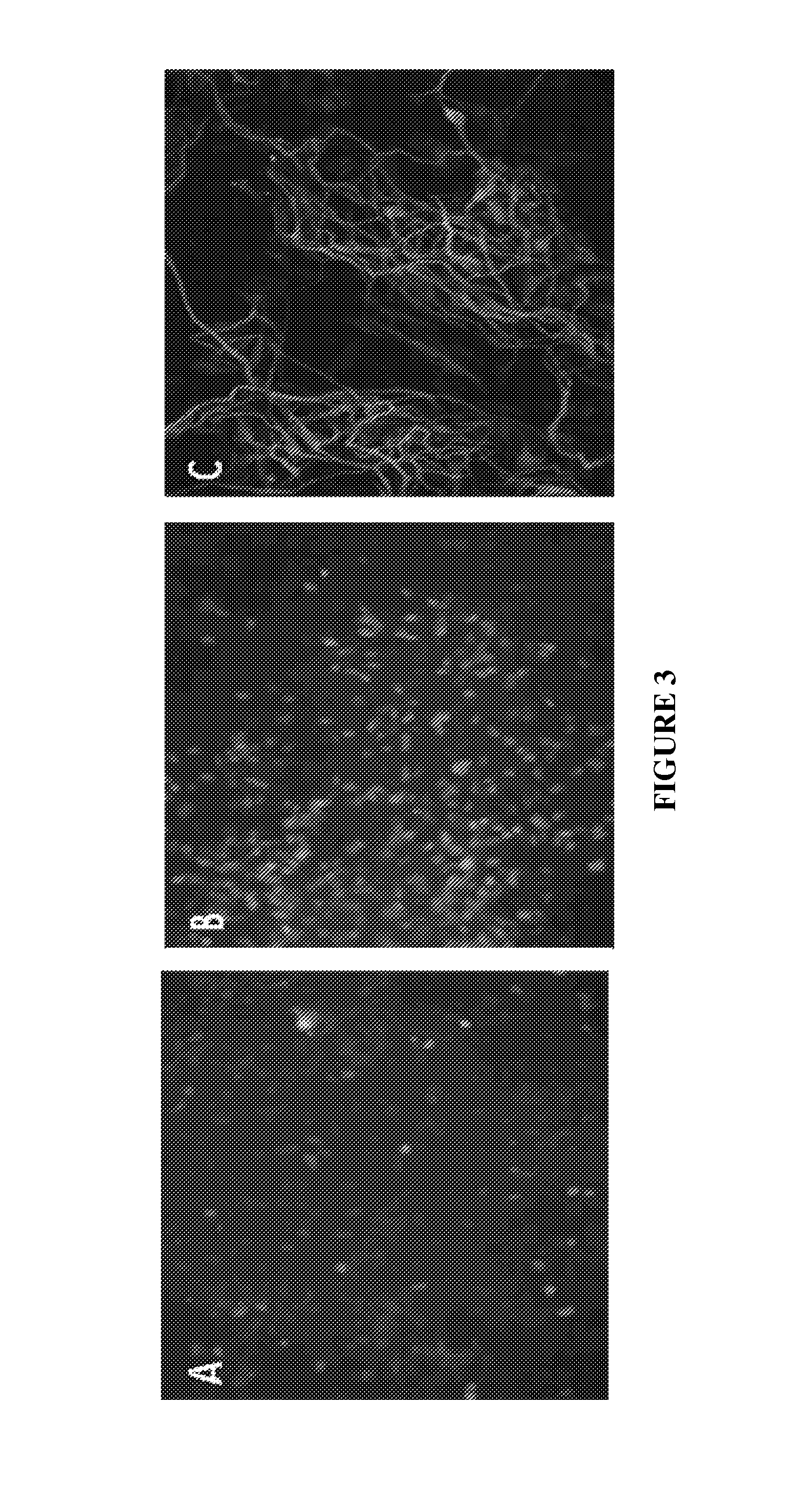Method of in vitro differentiation of motor neuron progenitors (MNPS) from human induced pluripotent stem cells and cryopreservation of mnps
a technology of human induced pluripotent stem cells and in vitro differentiation, which is applied in the field of in vitro differentiation of motor neuron progenitors (mnps) from human induced pluripotent stem cells and cryopreservation of mnps, can solve the problems of difficult to consistently achieve sufficient neural induction to efficiently produce mnps, and achieves a high yield, high yield, and reproducibility. high
- Summary
- Abstract
- Description
- Claims
- Application Information
AI Technical Summary
Benefits of technology
Problems solved by technology
Method used
Image
Examples
example 1
Differentiation of hESCs
[0051]Materials and Experimental Design
[0052]Initiation of Motorneuron Differentiation Day 0
[0053]Human ESCs or iPSCs were co-cultured with MEF feeder cells with hESC growth medium (knockout DMEM / F12, 20% KSR, Glutamax, NEAA, BME and bFGF) on the T75 flask (FIG. 2A). hESCs were initiated when the cell density reached around 80% confluence. Spent medium from the T-75 flask was replaced with 30 ml of a 1:1 mixture of hESC medium and MNP induction medium supplemented with 10 ng / ml bFGF. After 24 hours, the hESCs / iPSCs colonies were dissociated using a collagenase solution (1 mg / ml) and the dissociated cells were suspended with MNP induction medium supplemented with 10 ng / ml bFGF and 10 μM of retinoic acid. The cell suspension then was transferred into an ultra-low-adherence T-75 flask.
[0054]Medium was gently replaced daily for 7 days without breaking cellular aggregates (FIG. 2B). Cell suspension along with the spent medium was transferred into a 50 ml conical t...
example 2
Harvest and Cryopreservation of Mnps
[0066]Materials and Experimental Design
[0067]On Day 30 or Day 31, four T-75 flasks were coated with 7 ml per flask of 0.1% gelatin solution and incubated for 30 minutes in the incubator. Approximately 150 ml of MNP induction medium were pre-warmed. The spent medium from the T-75 flasks was aspirated and the flasks were washed once with 15 ml of PBS each. Five ml of TrypLE solution were added and incubated 3-10 minutes. The flask was examined every 3 minutes until most cells were dissociated. Ten ml of MNP induction medium were added to each flask and the suspension was transferred into 50 ml conical tubes. Each T-75 flask was rinsed with an additional 10 ml of medium and the solution was transferred to the 50 ml tubes. The tubes were centrifuged at 200×g for 3 minutes at room temperature. The supernatant was aspirated and the cell pellet was resuspended in 20 ml of medium and the suspension was transferred into the gelatin-coated T-75 flasks (10 m...
example 3
Plating of Motor Neuron
[0070]Materials and Experimental Design
[0071]Plate Coating
[0072]Each 96 well plate required 10 ml of poly-D-lysine working solution (50 μg / ml). The required amount of poly-D-lysine working solution was transferred into a sterile reagent reservoir. Using a multi-channel pipettor, each well of a 96 well plate was coated with 100 μl of poly-D-lysine working solution and the plates were placed in the incubator overnight. After incubation, the poly-D-lysine solution was aspirated using a multi-channel aspirator. The wells were rinsed twice with 100 μl per well of PBS. The plates were dried in the laminar flow hood with the lids off for at least 1 hour and were ready for laminin coating. The required amount of laminin working solution (15 μg / ml) was prepared in MNP basal medium (without B27 / NSF1). Using a multi-channel pipettor, 75 μl of laminin working solution were added per well. The plates were incubated at 37° C. for at least one hour but no longer than six hou...
PUM
| Property | Measurement | Unit |
|---|---|---|
| concentration | aaaaa | aaaaa |
| concentration | aaaaa | aaaaa |
| temperature | aaaaa | aaaaa |
Abstract
Description
Claims
Application Information
 Login to View More
Login to View More - R&D
- Intellectual Property
- Life Sciences
- Materials
- Tech Scout
- Unparalleled Data Quality
- Higher Quality Content
- 60% Fewer Hallucinations
Browse by: Latest US Patents, China's latest patents, Technical Efficacy Thesaurus, Application Domain, Technology Topic, Popular Technical Reports.
© 2025 PatSnap. All rights reserved.Legal|Privacy policy|Modern Slavery Act Transparency Statement|Sitemap|About US| Contact US: help@patsnap.com



